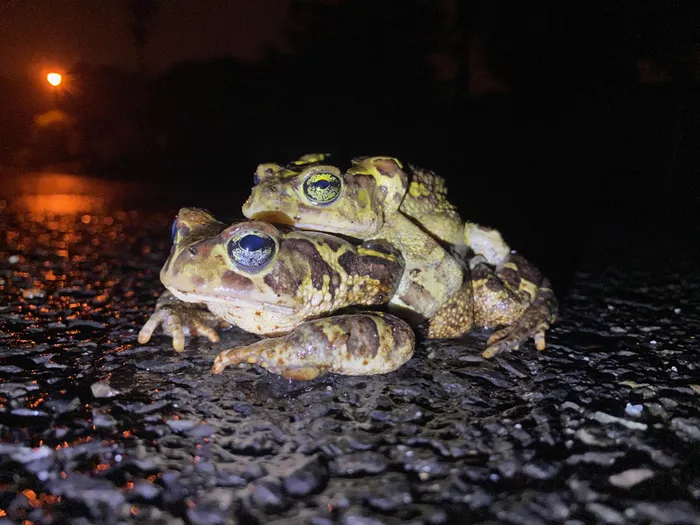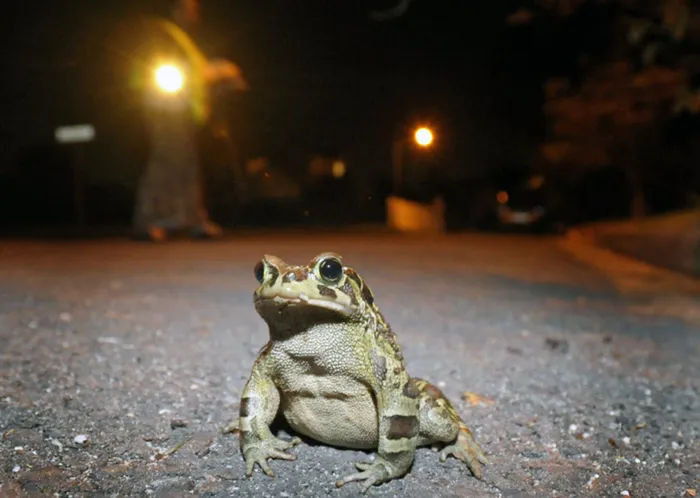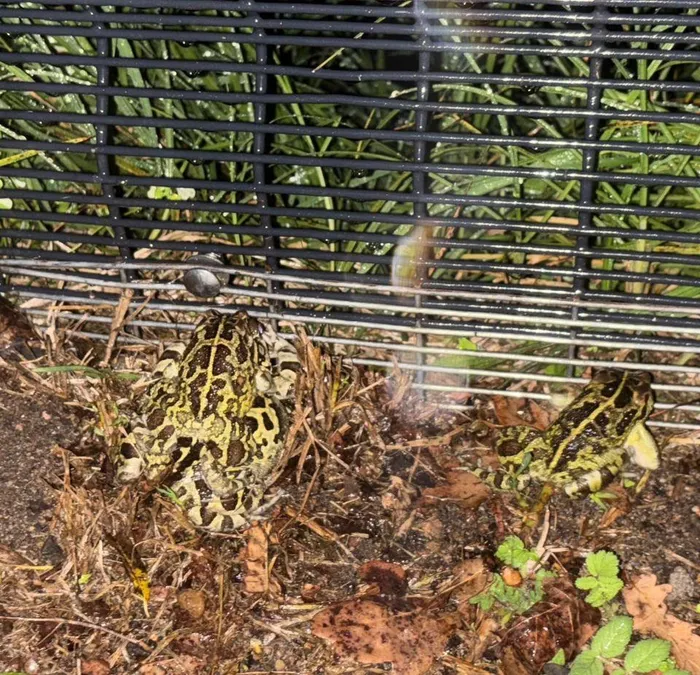Fencing jeopardises breeding grounds of endangered Western Leopard Toads

Two Western Leopard Toads are currently migrating for breeding season
Image: Supplied
A historic breeding pond used by the endangered Western Leopard Toad in Constantia has been fenced off and conservationists are warning of devastating consequences for the species.
The recent fence installation along Schoenstatt Avenue, has raised concerns amongst conservation groups.
One such, Toad Nuts says a perimeter fence was erected without proper environmental consideration, cutting off access to a vital pond used by the toads each winter.
“These ponds are vital for these animals,” said Toad Nuts spokesperson Alison Faraday.
“They live in our gardens through summer, and in winter they migrate to breed. They follow the smell of water and they don’t know how to go around fences.”
A City official reportedly recommended that a 10cm clearance be left at the bottom of the fence to allow toads through. It seems that while this was initially implemented, additional fencing was later added, largely blocking access again.
The Western Leopard Toad, endemic to the Western Cape, is facing increasing threats not only from development but from traffic..
“They get killed in their hundreds,” said Faraday. “During the breeding season we have volunteers already stretched thin — out every night trying to carry them around fences or off roads.”
The breeding migration, which peaks in August, is crucial for the toads’ survival. “If they don’t breed, their numbers will drop dramatically. They’re a key species, part of the food chain, and they help control insect populations in our gardens.”
Faraday added that previous efforts by the City to regulate fencing near breeding ponds have since fallen away, and the lack of legislation is worsening the situation. “We’ve been raising this for years. There were guidelines. But all of it was scrapped.”
The organisation is calling for urgent action both legislative and community-based.
“This isn’t just a toad problem. It’s about how we share space with other species. Right now, we’re failing them.” Faraday suggests that all home owners should consider installing small openings in the bottom of their fences and walls to allow freedom of movement for smaller wildlife.
The Two Oceans Aquarium also recently urged motorists to slow down and check for toads crossing roads, particularly in known migration hotspots like Kirstenhof, Lakeside, Tokai, and Noordhoek and explained the importance of preserving this animal.
“The Western leopard toad is endemic to the Western Cape, meaning that our province is the only place in the world where these elusive amphibians live.

Cape Town 100825. A leopard Toad is seen by a Toader in a street in Bergfleit. Toaders have been helping the Toads accross the road because they are often hit by cars. PHOTO SAM CLARK A leopard Toad in the road, in Bergvliet.
Image: File
“They benefit humans by eating various insects including mosquitoes. They are most active from late July to September, and especially in August at breeding time. When the winter rains start to fall, the toads migrate from residential areas to water to breed.
“The males are the first to make their way to the water and when they are ready, they start calling the females with loud, snoring calls.”
They encouraged volunteers in various areas to help patrol the roads at night and to move toads across the roads to safety.
“In August, Western leopard toads in their numbers can be seen crossing roads around the Cape Peninsula. This migration is fraught with danger, as the toads have to navigate busy suburban roads at night. Already, many have lost their lives due to cars.
“In an interaction between a toad and a car, the toad always comes off as second best,” said Helen Lockhart, Two Oceans Aquarium Conservation and Sustainability Manager.
“All you need is warm clothing, torch and a cellphone with GPS. The Coordinator will explain exactly what to do in the area you cover” Lockhart concluded.
The City of Cape Town has confirmed that no building plans were submitted or approved for a recently erected fence that has sparked concern among environmentalists working to protect the endangthe City’s Deputy Mayor and Mayoral Committee Member for Spatial Planning and Environment, Alderman Eddie Andrews, said:
“To the best of my knowledge, and subject to confirmation from the relevant Built Environment Management Department (BDM), no formal building plan application or approval for this specific fence installation was submitted. Consequently, the Environmental & Heritage Management (E&HM) Branch did not assess or approve any fencing plans in this instance.”
He added that an Environmental Impact Assessment (EIA) was not required in this case:
“Based on the nature and scale of the fence installation, no listed activity under the National Environmental Management Act (NEMA) was triggered. Therefore, an Environmental Impact Assessment (EIA) or Basic Assessment process was not required.”

The fencing locking the toads from migrating
Image: Supplied
Although no legislation prohibits fencing near faunal movement corridors, Andrews said the City takes biodiversity conservation seriously and actively engages with developers:
“While there is no specific legislation or municipal regulation that prohibits fencing in proximity to known faunal movement corridors, the City does take the conservation of local biodiversity seriously.”
Andrews acknowledged there is currently no formal requirement for private developments to include wildlife-friendly features, but said the City does encourage this in certain areas, particularly where developments occur adjacent to wetlands, breeding sites, or known faunal corridors.
According to Andrews, the City has already engaged with the Schoenstatt estate following complaints:
“Following concerns raised by the volunteer Western Leopard Toad conservation group, the Estate Manager of the Schoenstatt Retreat Centre approached me directly.
"A site meeting was conducted, during which the City’s Environmental Management Department provided guidance on how the fencing could be modified to facilitate toad movement. I also highlighted the ecological importance of the nearby wetland and downstream breeding pond, which is a recognised site for Sclerophrys pantherina (Western Leopard Toad).”
While no environmental laws have been broken, Andrews said the City will continue supporting conservation efforts through education and voluntary compliance.
He concluded: “The City of Cape Town remains committed to the protection of its rich biodiversity and works in partnership with local conservation groups, volunteers, and residents to promote coexistence between development and nature.
“While enforcement mechanisms may be limited in cases such as this, we will continue to advocate for environmentally responsible practices and provide guidance to mitigate risks to endangered species.”
tracy-lynn.ruiters@inl.co.za